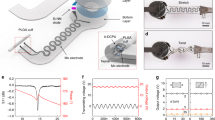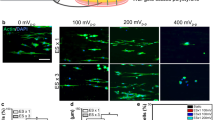Abstract
Peripheral nerve injuries represent a significant problem in public health, constituting 2–5% of all trauma cases1. For severe nerve injuries, even advanced forms of clinical intervention often lead to incomplete and unsatisfactory motor and/or sensory function2. Numerous studies report the potential of pharmacological approaches (for example, growth factors, immunosuppressants) to accelerate and enhance nerve regeneration in rodent models3,4,5,6,7,8,9,10. Unfortunately, few have had a positive impact in clinical practice. Direct intraoperative electrical stimulation of injured nerve tissue proximal to the site of repair has been demonstrated to enhance and accelerate functional recovery11,12, suggesting a novel nonpharmacological, bioelectric form of therapy that could complement existing surgical approaches. A significant limitation of this technique is that existing protocols are constrained to intraoperative use and limited therapeutic benefits13. Herein we introduce (i) a platform for wireless, programmable electrical peripheral nerve stimulation, built with a collection of circuit elements and substrates that are entirely bioresorbable and biocompatible, and (ii) the first reported demonstration of enhanced neuroregeneration and functional recovery in rodent models as a result of multiple episodes of electrical stimulation of injured nervous tissue.
This is a preview of subscription content, access via your institution
Access options
Access Nature and 54 other Nature Portfolio journals
Get Nature+, our best-value online-access subscription
$29.99 / 30 days
cancel any time
Subscribe to this journal
Receive 12 print issues and online access
$209.00 per year
only $17.42 per issue
Buy this article
- Purchase on Springer Link
- Instant access to full article PDF
Prices may be subject to local taxes which are calculated during checkout




Similar content being viewed by others
Data availability
The data that support the findings of this study are available from the corresponding author on reasonable request.
References
Noble, J., Munro, C. A., Prasad, V. S. & Midha, R. Analysis of upper and lower extremity peripheral nerve injuries in a population of patients with multiple injuries. J. Trauma 45, 116–122 (1998).
Kemp, S. W. P., Cederna, P. S. & Midha, R. Comparative outcome measures in peripheral regeneration studies. Exp. Neurol. 287, 348–357 (2017).
Sakiyama-Elbert, S. E. & Hubbell, J. A. Controlled release of nerve growth factor from a heparin-containing fibrin-based cell ingrowth matrix. J. Control Release 69, 149–158 (2000).
Sakiyama-Elbert, S. E. & Hubbell, J. A. Development of fibrin derivatives for controlled release of heparin-binding growth factors. J. Control Release 65, 389–402 (2000).
Taylor, S. J., McDonald, J. W. 3rd & Sakiyama-Elbert, S. E. Controlled release of neurotrophin-3 from fibrin gels for spinal cord injury. J. Control Release 98, 281–294 (2004).
Maxwell, D. J., Hicks, B. C., Parsons, S. & Sakiyama-Elbert, S. E. Development of rationally designed affinity-based drug delivery systems. Acta Biomater. 1, 101–113 (2005).
Wood, M. D. et al. Fibrin matrices with affinity-based delivery systems and neurotrophic factors promote functional nerve regeneration. Biotechnol. Bioeng. 106, 970–979 (2010).
Konofaos, P. & Terzis, J. K. FK506 and nerve regeneration: past, present, and future. J. Reconstr. Microsurg. 29, 141–148 (2013).
Labroo, P. et al. Controlled delivery of FK506 to improve nerve regeneration. Shock 46, 154–159 (2016).
Labroo, P., Shea, J., Sant, H., Gale, B. & Agarwal, J. Effect of combining FK506 and neurotrophins on neurite branching and elongation. Muscle Nerve 55, 570–581 (2017).
Gordon, T. Electrical stimulation to enhance axon regeneration after peripheral nerve injuries in animal models and humans. Neurotherapeutics 13, 295–310 (2016).
Nix, W. A. & Hopf, H. C. Electrical stimulation of regenerating nerve and its effect on motor recovery. Brain Res. 272, 21–25 (1983).
Ray, W. Z., Mahan, M. A., Guo, D., Guo, D. & Kliot, M. An update on addressing important peripheral nerve problems: challenges and potential solutions. Acta Neurochir. (Wien) 159, 1765–1773 (2017).
Cuoco, F. A. Jr & Durand, D. M. Measurement of external pressures generated by nerve cuff electrodes. IEEE Trans. Rehabil. Eng. 8, 35–41 (2000).
Leventhal, D. K., Cohen, M. & Durand, D. M. Chronic histological effects of the flat interface nerve electrode. J. Neural Eng. 3, 102–113 (2006).
Grill, W. M. & Mortimer, J. T. Neural and connective tissue response to long-term implantation of multiple contact nerve cuff electrodes. J. Biomed. Mater. Res. 50, 215–226 (2000).
Zierhofer, M. C. & Hochmair, E. S. Transcutaneous transmission of digital data and energy in a cochlear prosthesis system. Int. J. Artif. Organs 15, 379–382 (1992).
Winter, K. F., Hartmann, R. & Klinke, R. A stimulator with wireless power and signal transmission for implantation in animal experiments and other applications. J. Neurosci. Methods 79, 79–85 (1998).
Kang, S. K. et al. Bioresorbable silicon electronic sensors for the brain. Nature 530, 71–76 (2016).
Wodzicka, M. Studies on the thickness and chemical composition of the skin of sheep. N.Z. J. Agric. Res. 1, 582–591 (1958).
Fornage, B. D. & Deshayes, J. L. Ultrasound of normal skin. J. Clin. Ultrasound 14, 619–622 (1986).
Hwang, S. W. et al. Dissolution chemistry and biocompatibility of single-crystalline silicon nanomembranes and associated materials for transient electronics. ACS Nano 8, 5843–5851 (2014).
Yin, L. et al. Dissolvable metals for transient electronics. Adv. Funct. Mater. 24, 645–658 (2014).
Rojas-Molina, R., De León-Zapata, M. A., Saucedo-Pompa, S., Aguilar-Gonzalez, M. A. & Aguilar, C. N. Chemical and structural characterization of Candelilla (Euphorbia antisyphilitica Zucc.). J. Med. Plant Res. 7, 702–705 (2013).
Petersson, A. E. et al. Wax esters produced by solvent-free energy-efficient enzymatic synthesis and their applicability as wood coatings. Green Chem. 7, 837–843 (2005).
Vieira, M. G. A., da Silva, M. A., dos Santos, L. O. & Beppu, M. M. Natural-based plasticizers and biopolymer films: a review. Eur. Polym J. 47, 254–263 (2011).
Gamble, P., Stephen, M., MacEwan, M. & Ray, W. Z. Serial assessment of functional recovery following nerve injury using implantable thin-film wireless nerve stimulators. Muscle Nerve 54, 1114–1119 (2016).
Brushart, T. M. et al. Electrical stimulation promotes motoneuron regeneration without increasing its speed or conditioning the neuron. J. Neurosci. 22, 6631–6638 (2002).
Elzinga, K. et al. Brief electrical stimulation improves nerve regeneration after delayed repair in Sprague Dawley rats. Exp. Neurol. 269, 142–153 (2015).
Gordon, T., Amirjani, N., Edwards, D. C. & Chan, K. M. Brief post-surgical electrical stimulation accelerates axon regeneration and muscle reinnervation without affecting the functional measures in carpal tunnel syndrome patients. Exp. Neurol. 223, 192–202 (2010).
Gordon, T. & English, A. W. Strategies to promote peripheral nerve regeneration: electrical stimulation and/or exercise. Eur. J. Neurosci. 43, 336–350 (2016).
Gordon, T., Udina, E., Verge, V. M. K. & de Chaves, E. I. P. Brief electrical stimulation accelerates axon regeneration in the peripheral nervous system and promotes sensory axon regeneration in the central nervous system. Motor Control 13, 412–441 (2009).
Willand, M. P., Nguyen, M. A., Borschel, G. H. & Gordon, T. Electrical stimulation to promote peripheral nerve regeneration. Neurorehabil. Neural Repair 30, 490–496 (2016).
Christensen, M. B., Wark, H. A. C. & Hutchinson, D. T. A histological analysis of human median and ulnar nerves following implantation of Utah slanted electrode arrays. Biomaterials 77, 235–242 (2016).
Srinivasan, A. et al. Microchannel-based regenerative scaffold for chronic peripheral nerve interfacing in amputees. Biomaterials 41, 151–165 (2015).
Sasaki, R. et al. PLGA artificial nerve conduits with dental pulp cells promote facial nerve regeneration. J. Tissue Eng. Regen. Med. 5, 823–830 (2011).
Yang, Y. et al. Biocompatibility evaluation of silk fibroin with peripheral nerve tissues and cells in vitro. Biomaterials 28, 1643–1652 (2007).
Anderson, J. M. & Shive, M. S. Biodegradation and biocompatibility of PLA and PLGA microspheres. Adv. Drug Deliv. Rev. 64, 72–82 (2012).
Gu, X., Zheng, Y., Cheng, Y., Zhong, S. & Xi, T. In vitro corrosion and biocompatibility of binary magnesium alloys. Biomaterials 30, 484–498 (2009).
Lee, S. et al. Metal microparticle: polymer composites as printable, bio/ecoresorbable conductive inks. Mater. Today 21, 207–215 (2018).
Lee, Y. RFID Coil Design. Report No. AN678 http://ww1.microchip.com/downloads/en/AppNotes/00678b.pdf (Microchip Technology Inc., 1998).
Hingne, P. M. & Sluka, K. A. Differences in waveform characteristics have no effect on the anti-hyperalgesia produced by transcutaneous electrical nerve stimulation (TENS) in rats with joint inflammation. J. Pain 8, 251–255 (2007).
Barr, J. O., Nielsen, D. H. & Soderberg, G. L. Transcutaneous electrical nerve stimulation characteristics for altering pain perception. Phys. Ther. 66, 1515–1521 (1986).
Patel, N. B., Xie, Z., Young, S. H. & Poo, M. Response of nerve growth cone to focal electric currents. J. Neurosci. Res. 13, 245–256 (1985).
Winter, W. G., Schutt, R. C., Sisken, B. F. & Smith, S. D. Effects of low levels of direct current on peripheral nerve regeneration. Trans. Orthop. Res. Soc. 6, 304 (1981).
Hunter, D. A. et al. Binary imaging analysis for comprehensive quantitative histomorphometry of peripheral nerve. J. Neurosci. Methods 166, 116–124 (2007).
Mendez, J. & Keys, A. Density and composition of mammalian muscle. Metabolism 9, 184–188 (1960).
Gans, C. Fiber architecture and muscle function. Exerc. Sport Sci. Rev. 10, 160–207 (1982).
Kalliainen, L. K., Jejurikar, S. S., Liang, L. W., Urbanchek, M. G. & Kuzon, W. M. Jr A specific force deficit exists in skeletal muscle after partial denervation. Muscle Nerve 25, 31–38 (2002).
Acknowledgements
S.-K.K. is supported by a National Research Foundation of Korea (NRF) grant funded by the Korean government (MSIT) (NRF-2018R1C1B5043901). H.M.L. is supported by a grant from NRF funded by the Korean government (MEST) (2011-0028612). Z.X. acknowledges support from the National Natural Science Foundation of China (grant no.11402134). Y.H. acknowledges support from National Science Foundation (grant nos. 1400169, 1534120, and 1635443). J.A.R. acknowledges support from DARPA and from the Center for Bio-Integrated Electronics at Northwestern University. We thank S. J. Robinson (Beckman Institute, University of Illinois at Urbana-Champaign) and K. Doty (Department of Comparative Biosciences Histology Service Laboratory, University of Illinois at Urbana-Champaign) for histology staining and images that greatly improved the manuscript.
Author information
Authors and Affiliations
Contributions
J. Koo, S.-K.K., S.M.W., Y.-Y.C., S.C., and J.A.R. designed and made the device. J. Koo, M.R.M., S.-K.K., S.B.K., S.M.L., J. Kim, R.Z., J.S., D.V.H., A.B., H.M.L., W.Z.R., and J.A.R. conceived the idea and performed the experiments and analysis. M.R.M., M.S., P.G., N.B., J. Khalifeh, Z.S.Z., K.B., M.P., Y.Y., and W.Z.R. performed the animal surgery, collected the nerve regeneration data, and analyzed the immunohistochemistry. Z.X., K.L., B.J., and Y.H. designed the antennas and ran the electromagnetic simulation. J. Koo, S.-K.K., M.R.M., Y.H., W.Z.R., and J.A.R. wrote the manuscript.
Corresponding authors
Ethics declarations
Competing interests
The authors declare no competing interests.
Additional information
Publisher’s note: Springer Nature remains neutral with regard to jurisdictional claims in published maps and institutional affiliations.
Supplementary information
Supplementary Text and Figures
Supplementary Figures 1–17
Supplementary Video 1
Twitch response by stimulating sciatic nerve with bioresorbable stimulator
Rights and permissions
About this article
Cite this article
Koo, J., MacEwan, M.R., Kang, SK. et al. Wireless bioresorbable electronic system enables sustained nonpharmacological neuroregenerative therapy. Nat Med 24, 1830–1836 (2018). https://doi.org/10.1038/s41591-018-0196-2
Received:
Accepted:
Published:
Issue Date:
DOI: https://doi.org/10.1038/s41591-018-0196-2
This article is cited by
-
Fully bioresorbable hybrid opto-electronic neural implant system for simultaneous electrophysiological recording and optogenetic stimulation
Nature Communications (2024)
-
Digital automation of transdermal drug delivery with high spatiotemporal resolution
Nature Communications (2024)
-
Highly Elastic, Bioresorbable Polymeric Materials for Stretchable, Transient Electronic Systems
Nano-Micro Letters (2024)
-
Advances in Wireless, Batteryless, Implantable Electronics for Real-Time, Continuous Physiological Monitoring
Nano-Micro Letters (2024)
-
Monolithic-to-focal evolving biointerfaces in tissue regeneration and bioelectronics
Nature Chemical Engineering (2024)



